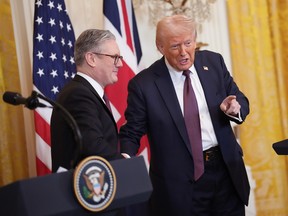
Article content
The United States and United Kingdom announced a trade deal Thursday, the first significant pact since U.S. President Donald Trump unleashed his so-called “Liberation Day” tariffs on April 2. Those tariffs, which applied to more than 50 countries and reached eye-watering levels nearing 50 per cent in some cases, were paused until July, with the U.S. administration claiming that countries were rushing to make make deals to avert a full-on trade war. Here’s what you need to know about the agreement with the U.K. and what it could mean for Canada’s own negotiations with the U.S.
THIS CONTENT IS RESERVED FOR SUBSCRIBERS ONLY
Subscribe now to read the latest news in your city and across Canada.
- Exclusive articles from Barbara Shecter, Joe O'Connor, Gabriel Friedman, and others.
- Daily content from Financial Times, the world's leading global business publication.
- Unlimited online access to read articles from Financial Post, National Post and 15 news sites across Canada with one account.
- National Post ePaper, an electronic replica of the print edition to view on any device, share and comment on.
- Daily puzzles, including the New York Times Crossword.
SUBSCRIBE TO UNLOCK MORE ARTICLES
Subscribe now to read the latest news in your city and across Canada.
- Exclusive articles from Barbara Shecter, Joe O'Connor, Gabriel Friedman and others.
- Daily content from Financial Times, the world's leading global business publication.
- Unlimited online access to read articles from Financial Post, National Post and 15 news sites across Canada with one account.
- National Post ePaper, an electronic replica of the print edition to view on any device, share and comment on.
- Daily puzzles, including the New York Times Crossword.
REGISTER / SIGN IN TO UNLOCK MORE ARTICLES
Create an account or sign in to continue with your reading experience.
- Access articles from across Canada with one account.
- Share your thoughts and join the conversation in the comments.
- Enjoy additional articles per month.
- Get email updates from your favourite authors.
THIS ARTICLE IS FREE TO READ REGISTER TO UNLOCK.
Create an account or sign in to continue with your reading experience.
- Access articles from across Canada with one account
- Share your thoughts and join the conversation in the comments
- Enjoy additional articles per month
- Get email updates from your favourite authors
Sign In or Create an Account
or
Article content
Article content
Article content
What’s in the deal?
Article content
By signing up you consent to receive the above newsletter from Postmedia Network Inc.
Article content
The deal includes some relief on recent tariffs for the United Kingdom, including on steel and aluminum, though details were not immediately released. There is also a tariff-rate quota on automobiles, allowing for 100,000 autos to be exported to the U.S. at a reduced tariff rate of 10 per cent, lower than the 25 per cent initially imposed by the U.S. on all foreign made cars. In exchange, the U.K. will open its market to U.S. agricultural products including beef and produce, as well as ethanol. Trump said this represents a “$5 billion opportunity” for the United States. It was expected that the U.K. would have to make concessions on its digital services tax, but that was not mentioned by either side in the announcement. “We wouldn’t rule it out yet with negotiations still ongoing,” economists at Toronto-Dominion Bank said in a note Thursday. Trump said there was also a special carve-out for Rolls-Royce Holdings PLC, allowing airport engines to be exported to Boeing tariff-free — while the U.K would later announce a commitment to buy $10 billion worth of Boeing planes. He also said that the U.K. will be joining the U.S. in taking steps to counter “dumping” of steel and aluminum to bolster the industry.
Article content
Article content
How significant is the deal?
Article content
Article content
While Trump boasted that the deal is full and “comprehensive,” it covers only limited sectors and reduces some tariffs, while adding some access for the U.S. and U.K to each other’s markets. The announcement is expected to be followed by months of work to hammer out further details and paper the deal. “It’s more symbolic than economic,” according to the TD economists, led by chief economist Beata Caranci, who wrote that the agreement is actually a 12-month pact, which is to be followed by a larger agreement still to be negotiated. U.K. Prime Minister Keir Starmer joined Trump’s news conference in the Oval Office remotely and hailed it as a “really fantastic historic day,” adding that the timing of the trade agreement announcement coincided with the end of the Second World War in Europe 80 years ago. However, Peter Mandelson, the U.K. ambassador to the United States, who was in the Oval Office, referred to the trade deal as a beginning. “There is yet more we can do in reducing tariffs and trade barriers so as to open up our markets to each other, even more than we’re agreeing to do today, but it also provides us with the platform,” he said. The trade announcements are not comprehensive, said William Pellerin, a partner in the international trade group at McMillan LLP. “Although the agreement may benefit both (countries) … relief will be sectoral and address a few irritants,” he said “Any broad or comprehensive agreement would require approval by the U.S. Congress, and that may not yet be in the cards.”

.jpg) 3 hours ago
1
3 hours ago
1
 English (US)
English (US)